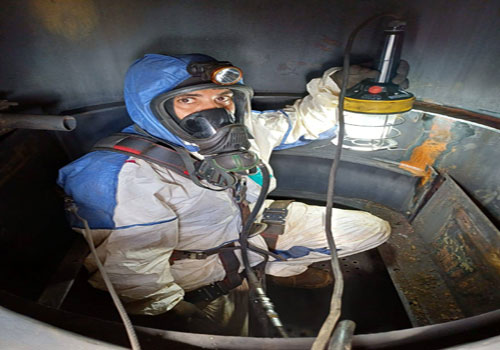
Confined Space Entry CSE refers to the process of accessing and working within spaces that have limited means of entry or exit and are not designed for continuous occupancy. These spaces pose unique safety challenges due to their confined nature and potential hazards. When undertaking Confined Space Entry, it is crucial to adhere to stringent safety protocols to mitigate risks and ensure the well-being of personnel. Key aspects of CSE include:
Confined Space Entry CSE training and Competency
Confined Space Entry (CSE) training and competency are crucial components of ensuring the safety of workers who need to enter confined spaces as part of their job duties. Here are key aspects of Confined Space Entry training and competency:
Identification of Confined Spaces: Training should include education on how to identify confined spaces in the workplace.
Hazard Recognition and Assessment:
Workers must be trained to recognize potential hazards within confined spaces.
Use of Personal Protective Equipment (PPE): Proper selection, use, and maintenance of personal protective equipment, such as respiratory protection, fall protection, and other specialized gear, should be covered in training.
Emergency Procedures: Workers must be familiar with emergency procedures, including rescue plans. This involves training on the use of rescue equipment and coordination with emergency services.
Communication: Confined Space Entry CSE training should cover communication protocols, including the use of signals and equipment like two-way radios.
Entry Permits and Procedures: Workers should be trained to obtain and work according to the confined space entry permit system.
Ventilation and Testing: Training should cover the proper methods for testing and ventilating confined spaces to ensure a safe atmosphere for entry.
Risk Assessment
Confined Space Entry CSE Risk assessment is a systematic process of identifying, evaluating, and prioritizing potential risks in a specific situation or activity. Here are the key steps involved in a typical risk assessment process:
Define the Scope and Objectives: Clearly define the scope of the risk assessment, including the objectives to be achieved.
Identify Hazards: Identify potential hazards or sources of harm that could lead to undesirable events.
Risk Identification: Assess the likelihood of each identified hazard occurring and the potential consequences if it does.
Assess and Evaluate Risks: Evaluate the identified risks by considering the likelihood and severity.
Risk Prioritization: Prioritize risks based on their level of severity and likelihood. This helps in focusing resources on addressing the most significant risks first.
Control Measures: Propose and assess control measures to mitigate or eliminate the identified risks.
Residual Risk Assessment: Confined Space Entry CSE evaluate the remaining (residual) risks after implementing control measures. Determine if the residual risk is at an acceptable level or if further actions are needed.
Confined Space Entry CSE communication
Confined Space Entry CSE Effective communication is crucial during Confined Space Entry (CSE) operations to ensure the safety of workers and facilitate a coordinated response in case of emergencies. Here are key aspects of communication in Confined Space Entry:
Pre-Entry Briefing: Before entering a confined space, conduct a pre-entry briefing to communicate the scope of work, potential hazards, and the entry plan
Two-Way Communication: Establish reliable two-way communication systems, such as radios or intercoms, between workers inside the confined space and those stationed outside
Check-In/Check-Out Procedures: Implement check-in/check-out procedures to track the entry and exit of personnel from the confined space.
Communication Protocols: Define and use clear communication protocols, including standardized signals or codes, to convey specific messages without ambiguity.
Emergency Communication Plan: Develop and communicate an emergency communication plan that includes procedures for alerting and evacuating personnel in the event of an emergency.
Continuous Monitoring: Maintain continuous communication and monitoring during the entire confined space entry.
Atmospheric Monitoring Communication: Clearly communicate the results of atmospheric monitoring, including oxygen levels and the presence of any toxic gases.
Personal Protective Equipment (PPE)
Confined Space Entry CSE refers to specialized clothing and equipment designed to protect individuals from various workplace hazards. The use of PPE is a critical component of a comprehensive safety program and is intended to reduce the risk of injury or illness in the workplace. Here are some common types of PPE:
Head Protection:
Hard Hats: Protect the head from impact due to falling objects, electrical shock, or other overhead hazards.
Eye and Face Protection:
Safety Glasses: Guard against impact, flying particles, and chemical splashes.
Face Shields: Protect the face from chemical splashes, dust, or flying debris.
Hearing Protection:
Earplugs and Earmuffs: Reduce exposure to high levels of noise.
Respiratory Protection:
Dust Masks and Respirators: Protect against airborne contaminants, dust, fumes, and gases.
Hand Protection:
Gloves: Shield hands from cuts, abrasions, chemicals, and other hazards. Types of gloves vary based on the specific task and materials being handled.
Foot Protection:
Safety Shoes or Boots: Provide protection against falling objects, crushing hazards, electrical shock, and punctures.
Body Protection:
Coveralls, Aprons, or Chemical-resistant Clothing: Protect the body from chemical splashes, sparks, and other hazards.
Fall Protection:
Harnesses, Lanyards, and Anchors: Prevent falls from heights. Used in construction, maintenance, and other elevated work.
High-Visibility Clothing:
Vests and Jackets: Enhance visibility in low-light conditions or areas with moving vehicles.
Permit-to-Work System
In Confined Space Entry (CSE), a Permit-to-Work (PTW) system is a formal written system used to control certain types of work that pose potential hazards.
This system is commonly employed in industries such as construction, manufacturing, maintenance, and other high-risk environments. The primary purpose of a Permit-to-Work system is to ensure that work is carried out safely and efficiently by controlling and managing potential hazards. Here are key components and principles of a Permit-to-Work system:
1. Authorization:
Only authorized personnel are allowed to issue and receive permits. This ensures that individuals responsible for safety are properly trained and knowledgeable about the hazards associated with the work.
2. Permit Issuance:
Before starting work on a specific task or in a designated area, a written permit must be obtained. The permit details the specific work to be performed, associated hazards, Safety Solutions and precautions, and other relevant information.
3. Risk Assessment:
A thorough risk assessment is conducted before issuing a permit. This involves identifying potential hazards, assessing the risks, and determining appropriate control measures to mitigate those risks.
4. Scope of Work:
The permit clearly defines the scope of work, including the tasks to be performed, the location, and any specific conditions or restrictions.
5. Duration and Expiry:
The permit specifies the duration for which it is valid. It should be time-limited to ensure that work is completed within a designated timeframe. If the work extends beyond the permit’s validity, a new permit must be obtained.
6. Communication:
The Permit-to-Work system emphasizes clear communication between all parties involved. This includes communication between the permit issuer, the person performing the work, and any other relevant stakeholders.
7. Isolation and Lockout/Tagout:
The permit addresses the need for isolating energy sources or machinery and incorporates lockout/tagout procedures when necessary to ensure the safety of workers.
8. Training and Competency:
Individuals involved in the permitting process and the execution of the work must be adequately trained and competent in their roles.
9. Emergency Procedures:
The permit includes information on emergency procedures and contacts. This ensures that workers are prepared to respond effectively to emergencies that may arise during the course of the work.
Emergency Response
In Confined Space Entry (CSE), a Permit-to-Work (PTW) system is a formal written system used to control certain types of work that pose potential hazards.
Here are key components and principles of a Permit-to-Work system:
Authorization:
Only authorized personnel are allowed to issue and receive permits. This ensures that individuals responsible for safety are properly trained and knowledgeable about the hazards associated with the work.
Permit Issuance:
Before starting work on a specific task or in a designated area, a written permit must be obtained.
Risk Assessment:
A thorough risk assessment is conducted before issuing a permit. This involves identifying potential hazards, assessing the risks, and determining appropriate control measures to mitigate those risks.
Scope of Work:
The permit clearly defines the scope of work, including the tasks to be performed, the location, and any specific conditions or restrictions.
Duration and Expiry:
The permit specifies the duration for which it is valid. It should be time-limited to ensure that work is completed within a designated timeframe. If the work extends beyond the permit’s validity, a new permit must be obtained.
Continuous Monitoring
Continuous monitoring refers to the ongoing, real-time assessment and observation of a process, system, environment, or condition to ensure its stability, safety, and compliance with established standards. Here are some key aspects and applications of continuous monitoring:
Environmental Monitoring:
Air Quality Monitoring: Continuous measurement of pollutants in the air to ensure compliance with regulatory standards.
Safety Monitoring:
Industrial Safety: Continuous monitoring of machinery and equipment to identify potential malfunctions or deviations from normal operating conditions.
Process Control:
Manufacturing Processes: Continuous monitoring of manufacturing processes to maintain product quality and identify deviations.
Healthcare Monitoring:
Patient Monitoring: Continuous monitoring of vital signs (e.g., heart rate, blood pressure, oxygen levels) for patients in hospitals or at home.
Cybersecurity Monitoring:
Network Security: Continuous monitoring of computer networks to detect and respond to security threats.
All these services are provided by CLC. For more details, please visit CLC website.
Additional important topics will be discussed with CLC Egypt at the event. Learn more about their services at egypes.com.


